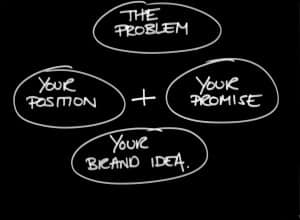I’m not going to lie to you – creating and implementing a content strategy is not easy. It’s hard. It’s hard to start, hard to build, hard to implement, and hard to get right. Why? Because your content strategy will guide your entire marketing effort. It’s the policy that everyone in your company will refer to when creating communications. As it says in the definition above, a synonym for “strategy” is “master plan”; your content strategy is the master plan, the framework, the game plan, of your company and marketing efforts. It’s a long-term, far-reaching, future-looking piece of work, and it’s hard to see everything that can possibly happen from now until infinity.
Phew – that’s a lot of pressure, isn’t it? You’re darn right it is, but when you get it right, it’s golden. Creating one of these massive things is well worth the time and trouble you go through to build it.
In this post, I’m going to outline the tactics to develop a content strategy. I don’t yet know how in depth I’ll get, but I’ll try not to make this post too long. Worst case, I can break it up into two posts. Here we go.
Tactic 1: Gather Information
Step 1: Know Thyself
Where are you, in terms of your online efforts? This is easy if you’re just starting out; not so easy if you’ve been around for a decade. The longer you’ve been around, the more the likelihood of having to pull information from a lot of sources.
- Do a content inventory. If you don’t know what this is or how to do one, read “Creating a Content Schedule? Inventory First!” Then come back; this article isn’t going anywhere. You’ll need an onsite and offsite inventory for a thorough, most helpful inventory.
- Check your link profile. You know you built up some links a few years ago for sure, and you’ve just assumed that those links are still sitting there, doing what they do, right? Wrong. Especially once the whole “bad link” thing hit, a lot of sites just set any outside link to “nofollow.” This is basically telling the search engines spiders that, while you felt a site was worth linking to, you don’t really want to associate with them. If you don’t have a subscription to Moz, MajesticSEO, SEMRush or something similar, I suggest you get one. You need to know who’s linking to you, what pages, and what those links are worth.
- Check your social. Review how many active followers you have across your social networks. If you have followers that haven’t put out a tweet in two years, for example, it’s time to cull the herd.
- Build your benchmark. We wrote a downloadable e-Book on measuring metrics walk-through and ow to set up a few benchmarks.
Step 2: Know Thy Enemy
Your competitors probably aren’t who you think they are. We often have companies tell us that “so and so” is their competitor, when it turns out that “so and so” isn’t even in their niche. Either that or they share the same niche without targeting the same terms. Knowing who your competition really is is essential. Read “Competitive Intelligence: Getting the Skinny on Your Competition,” to gain more in depth information on the steps below.
- Find your competition. This is the really the most important part of step 2. This is already an uphill battle; if you’re fighting the wrong competition, there’s no way you’re going to get ahead of them.
- Investigate the competition. Do they have links? Are they social? Who do they talk to?
Step 3: Know Thy Strengths and Weaknesses
Once you have your competitors’ information, it’s time to compare. Again, MOZ is a great tool for competitor comparisons. How do you stack up to the competition in:
- Social shares
- Inbound links to the target page
- Inbound links to the domain
- SERP ranking (for the target pages)
- Trust and citation flow
- Domain authority
Overall, remember that the competition can change depending on the page you’re trying to rank and the term you’re trying to rank for.
Step 4: Know Thy Target
It is critical that you understand your target market. To do this, you must choose and narrow down your special market segment. We’ve written numerous articles on finding your target audience:
- Repeat After Me: “Target. Market.”
- Behavioral Targeting, Conversion Psychology, Content Personalization, and Privacy: How To Get The Right Message To The Right People at the Right Time Without Being Creepy
- And then there’s turning visitors into targets with buyer psychology.
Once you know as much as you can about the current situation, it’s time to move on to tactic number 2.
Tactic 2: Define Your Objectives
You have your benchmarks, so you know where you are, but where do you want to be? Defining your objectives gives you the goals you’re reaching for.
Begin with rough ideas. At this point, the important part of defining your objectives is to have them written in front of you so you can define what is realistic and important. How will your content marketing strategy will help your business grow? For example:
- Objective #1: Increase visits from social shares by x
- Objective #2: Increase number of citations by x
- Objective #3: Increase inbound links by x
- Objective #4: Increase overall sales by x
This is where the first tactic of information gathering is really helpful, because it outlines where your weaknesses are. Compare your benchmarks to successful competitors and try to find weakness and strengths. For instance, if your competition has more social shares than you do, you know you can improve by upping your social shares.
Tactic 3: Create the Outline
The overall strategy is your game plan, but coming up with it all at once can be overwhelming. As well, you can miss a lot of things that way. If you’re going to be organized – if your content strategy is going to work, you need to create an outline. In the outline, include actions that consist of tasks you can easily accomplish. These tasks will fall under your objectives.
You can use an Excel spreadsheet to track your work and customize the spreadsheet in a way that works best for you. What’s important is that you have a way to record:
- what tasks you have to accomplish
- how often you have to do them
- whether you followed through
- when you followed through
Let’s use the Objective 1 example given in tactic 2:
Objective #1: Increase visits from social shares by x
- Task 1 – Share 2x’s a week on Facebook
- Task 2 – Spend one hour on Facebook, once a week, commenting, liking and so on.
- Task 3 – Spend one hour on Twitter, once a week: retweeting, commenting and so on.
- Task 4 – Add Social Graph data to my website
- Task 5 – Add Twitter Card meta to my website
Tactic 4: Refine Your Strategy
You have your outline, but how does it translate into all that major business heaviness I mentioned at the beginning? How does all this turn into your business’ communication policy? This is what tactic four does. You refine your content strategy and, in the process, refine your communications output.
- Shape your value proposition into a statement that will communicate the benefits of hiring you/buying from you. Peter Sandeen wrote an excellent article about building your value proposition. He writes, “…a strong value proposition is a believable collection of the most persuasive reasons your target customers should do what you’re hoping they will do.” It’s well worth the read.
- Break your value proposition down. What terms can you use to support it? What terms might your market use to search for your offering?
- Identify content types for effective communication. What are the best ways to communicate these messages (and your overall value proposition)? Articles? Blog posts? Videos? Podcasts? Documents and whitepapers? Read How to Build Content for SEO Without Bombarding Readers for additional information.
- Identify tone, style and length. -And remember, your entire company will use this, so make sure it outlines everything. If it’s a video, it should be x number of minutes. Blog posts should be no more than x number of words and no less than x number of words. Whitepapers should always have the logo in the left corner and the whitepaper title on the right (for example). Blog posts are always informal, using contractions and so forth. Whitepapers always use AP standards. Tweets will… and so on.
- Make a firm schedule of when you will publish which content pieces. You’ll post x blog posts per week. x number of “self” tweets will go out each month/week/day. You’ll create x number of whitepapers per month/year.
Also, don’t forget to create a set of “negatives.” What are the big don’ts for your company? What words do you absolutely not want used? For instance, a nutrition specialist may not ever want to use the word “diet” in conjunction with their offerings. This needs to go into your strategy, as well.
Tactic 5: Choose Your Tools
Once you have chosen your content properties, you must decide what online tools you’ll use to deliver them. Will you use WordPress, Drupal, Joomla, or one of the many other content management systems out there? Will you use YouTube or Vimeo? Or both? What will you use to track your social growth, or traffic growth? How will you track what traffic comes in through what channels?
This may sound like the easiest part. You might be thinking, “Well, that’s easy. YouTube.” or “WordPress, of course.” It’s not, because you have to know that your target market is using the same channels. So often, companies come to us that have pushed an awesome strategy into the wrong channel. Be where your audience is. It’s that simple.
Conclusion: There’s No TL; DR Version to Content Strategies
A while back, I read a blog that had a “TL; DR” (Too Long; Didn’t Read) summary at the bottom. I liked it so much that I thought I would incorporate it into my blog posts. I thought, “A summary for the scanner – brilliant!” While I still think it’s a great idea, there isn’t a TL; DR version for content strategies.
A well-planned content strategy is the result of considering several aspects of your business model and target demographic characteristics. It goes into every facet of your business, your competitors, and your target market. At the end of the day, it really is the master plan for how your business communicates with its competitors, consumers and advocates. You can’t shortcut it; you can’t cookie-cut it, you can’t scan through it. It’s a long, arduous process that will bring huge returns in the end.









































4 Responses
Hi Gabriella,
content is very important and helpful for get high traffic on website, this is good article and having some very good point which is awesome and helpful for improve your content quality.
Regards
John
Good stuff Gabriella, especially about knowing where your target audience hangs out. Lot’s of wasted content shared through the wrong channels!
Hey Quincy, thanks for taking the time to say so… cheers!